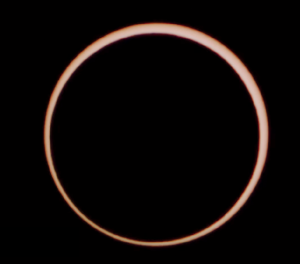“On October 14, 2023, there will be a solar eclipse.”

“On October 14, 2023, there will be a solar eclipse.”
“On October 14, 2023, a fascinating celestial event unfolded in the skies—an annular solar eclipse. During a solar eclipse, the moon passes between the Earth and the Sun, temporarily veiling the Sun from view for Earthbound observers. In the case of an annular solar eclipse, a striking visual occurs when the moon’s apparent size is slightly smaller than that of the Sun. This results in a captivating ring-like appearance, with the Sun’s edges still visible. Annular eclipses cast their partial shadow over a broad swath of Earth, spanning thousands of kilometers or miles. Remarkably, just 4.6 days after a total solar eclipse on October 10, 2023, the moon’s apparent diameter diminished, setting the stage for this unique astronomical spectacle.”
The eclipse’s captivating journey unfolded across the United States, commencing in Oregon and weaving through a diverse tapestry of locales. From Dunes City and Newport to the stunning landscapes of Crater Lake National Park, the eclipse’s path created awe-inspiring moments for observers in Eugene and Medford.
As it ventured further, the eclipse embarked on an enchanting odyssey through the Modoc National Forest in California, gracing the Black Rock Desert and charming Winnemucca in Nevada. It continued its celestial tour, casting its shadow over the wondrous Canyonlands National Park, Glen Canyon National Recreation Area, and the picturesque town of Bluff in Utah.
Heading east, the eclipse painted its silhouette over the northeastern realm of Arizona, including Kayenta, and swept across the southwestern beauty of Colorado, embracing Cortez and the Ute Mountain Reservation.
The celestial phenomenon’s journey didn’t stop there. It traced a path over New Mexico, touching places like Farmington, Albuquerque, Santa Fe, Roswell, and Carlsbad. The eclipse then made its way into the heart of Texas, traveling through Midland, Odessa, San Angelo, Kerrville, San Antonio, and Corpus Christi before eventually disappearing into the vastness of the Gulf of Mexico.
This annular eclipse was a rare spectacle, gracing Albuquerque for the second time in 11 years, coinciding with the culmination of the Albuquerque International Balloon Fiesta. Looking ahead, future total solar eclipses promise to grace the United States in 2024 and 2045, creating more mesmerizing moments for skywatchers. In 2048, a unique total solar eclipse with a corona shape will unfold, leaving its mark on the path of celestial wonder.

